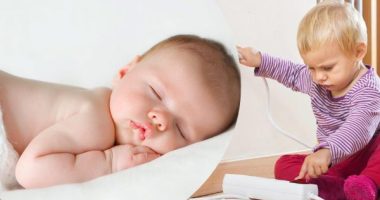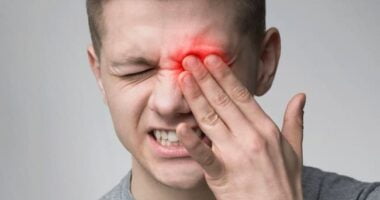Wrong sleep positions for Infants or newborns can sometimes lead to Sudden Infant Death Syndrome (SIDS).
SIDS in children is caused due to accidental suffocation or strangulation in bed. If you have an infant at home, it is essential that you know all about the safe and unsafe sleeping positions for babies and the risk involved in each sleeping position.
Safe Sleep Position
Sleep on back

Most people keep asking why ‘sleep on back’ is the best sleep position for infants?
The truth is, sleep on back position is considered the best sleeping position for babies because it’s the safest. It is the most suggested sleeping position for babies as it keeps the airways open.
The US National Institute of Child Health and Human Development (NICHD) recommends the sleep-on-back position for short naps as well as for sound sleep throughout the night in babies.
This recommendation of putting baby down on her back applies to infants throughout the first year of life. However, it is particularly important during the first six months (i.e 0-6months), when the incidence of SIDS is the highest.
So, once your baby can roll over (at around 4-6 months), keep putting him to sleep on his back for naps, short periods of rest, and sleep at night. But let him find his own sleeping position.
Risks Involved In ‘Sleep On Back’ Position
If newborns or infants are placed on the back for a long time on the same position, it could lead to a condition called ‘positional plagiocephaly’, a case of flattened or misshapen head.
The baby also may also suffer from ‘brachycephaly’, a case of flattened back of the skull.
But these are temporary conditions and the shape of both the skull and the back becomes normal as soon as the baby turns one and hardly needs any treatment.
Some simple reposition techniques that can help to avoid these conditions altogether include.
- Increasing ‘tummy time’ of the baby when awake
- Turning the baby on the sides while he/she is not asleep
- Reducing the time spent by babies in carriers or car-seaters.
- Increasing the baby’s ‘cuddle time’.
- Changing the direction of the baby in the crib so that he does not tend to view same things in one direction always.
Unsafe Sleep Position
Sleep on the stomach

Making newborns sleep on the stomach is not safe and it’s highly discouraged by health experts due to the following reasons:
- This position may put some pressure on baby’s jaws and block airways making it difficult for the baby to breathe.
- Sleeping on the stomach makes the baby lie with his face very close to the sheet, making him breathe the same air. This may result in breathing in recycled air which is low in oxygen
- Sleeping on the stomach on a very soft mattress may cause accidental suffocation in babies. The risk of rebreathing the exhaled air is higher while lying on a soft mattress because the baby’s face slacks deeper into the soft fabric of the mattress. This might block the baby’s airways from all sides.
- Also, because of the nose placed very close to the mattress in this position, the baby ends up breathing in the microbes present in the sheet covering the mattress, and this may lead to allergies
However, sometimes, in case of certain medical conditions, doctors may advise parents to put the baby to sleep in the stomach position rather than the back.
Usually, children with gastroesophageal reflux or certain upper-airway malformations like Pierre Robin Syndrome are advised to sleep in this position, but recent studies do not support this reasoning. Hence, it is advisable to consult the physician properly before putting your baby to sleep on his/her stomach.
The danger of vomiting was the most important argument for making the baby to sleep on its stomach, as doctors used to believe that it would be dangerous if the baby vomits while sleeping on the back. They used to think that babies may choke due to lack of sufficient strength to turn the head. However, babies sleeping on their backs have no difficulty turning their heads if they’re sick.
Also, you can make colicky baby sleep on the stomach to relieve him of gas. However, do not do it immediately after feeding him but give some gap between the feed and the sleep.
Sleep on the side

It’s not safe for a baby to sleep on the side. This is because an infant tends to eventually roll-on to their tummy while sleeping on the side and this increases the risk of Sudden Infant Death Syndrome (SIDS).
Safe Sleeping Tips For Babies And Newborns
Here are some tips to ensure that your baby has a sound and good night’s sleep.
1. Avoid Sharing Bed With Baby
Infants should ideally not share the bed with parents, adults, siblings or other children. Twins or multiples should be made to sleep separately. Do not share a bed with your baby especially if you or your partner has been drinking, smoking or taking medications or drugs that could induce deep sleep. Smoking and the use of a substance like drugs or alcohol significantly increase the risk of SIDS and suffocation in babies, if the bed is shared.
2. No Loose Bedding
It is advisable to use a firm mattress rather than an overly soft mattress, water-bed or sofa for your baby. Experts suggest against the usage of bumper pads, pillows, fluffy bedding or stuffed animals around the baby in the crib. In simple words, anything that could cover a baby’s head during sleep is not recommended.
3. Keep Baby Crib Simple
Usage of materials like quilts and comforters on top of the mattress to make the bedding soft must be avoided. It may make the baby sink under the bedding which can be risky in case of an infant. Just place a clean, fitting mattress inside the crib and cover it with a clean bed sheet, and that is enough for your baby to have a comfortable sleep.
4. Avoid Covering Baby’s Head
Blankets should be covered only up to the chest of the baby with arms exposed, to avoid the shifting of the blanket onto the head and thereby avoiding suffocation. The American Academy of Pediatrics recommends using ‘sleep sack’ or ‘baby sleep bag’ as a type of bedding to keep him warm without covering the head. Sleeping bags with a fitted neck and armholes and no hood are considered the safest. Wrapping baby in lightweight cotton or muslin also helps in preventing him from rolling onto his tummy during sleep.
5. Night Clothes Should Be Light Clothes
Infants should be light-clothed for sleep. Avoid over-bundling and check if the baby is not hot to touch. Overheating is a risk factor for SUDI including SIDS and fatal sleeping accidents.
Ask yourself what you would wear to bed and use that as a guide. Keep your baby’s head uncovered indoors – this allows your baby to cool and not overheat. Don’t worry if your baby’s hands and feet feel cool – that’s normal.
6. Good Sleep Environment
It is important to maintain a considerably cool sleeping environment with a temperature of around 20 degrees centigrade for the baby.
7. Vaccination
An investigation was done on diphtheria-tetanus-pertussis immunization and potential SIDS association by the Berlin School of Public Health has concluded that “increased DTP immunization coverage is associated with decreased SIDS mortality. Current recommendations on timely DTP immunization should be emphasized to prevent not only specific infectious diseases but also potentially SIDS.” Make sure your baby is immunized.
8. Use Technology
For you to have a peaceful sleep, use one of the several Wi-Fi baby monitors, app-powered thermostats, or small alarms available to monitor the sleep position as well as the vitals of your baby.
9. Share The Same Room
It is important that the baby’s crib is installed in the same room as the parents. It makes breastfeeding convenient, and it is easy for the parents to keep a close watch on the baby’s sleeping positions. Room-sharing and not bed-sharing is recommended by the AAP as a baby sleep safety guideline.
10. Use A Pacifiers If Necessary
The American Academy of Pediatrics considers pacifiers to prevent or reduce the risk of SIDS. However, if your baby doesn’t want the pacifier or if it falls out of her mouth, don’t force it. If you are breastfeeding, wait until breastfeeding is well established, usually around three or four weeks of age, before beginning to use a pacifier.
11. Educate Your Baby Carers
Make sure your baby’s carers know how to protect against SUDI
It’s best not to assume that other people know about safe sleeping practices, even professional childcarers. Have a look at the planned sleeping arrangements, and make sure that your baby will be positioned safely for sleep. For example, it isn’t recommended to leave a baby sleeping in a pram unsupervised.
VISIT OUR ONLINE STORE FOR – QUALITY HEALTH PRODUCTS @ AMAZING LOW PRICES









